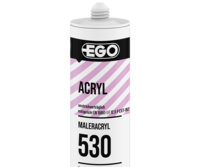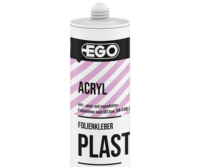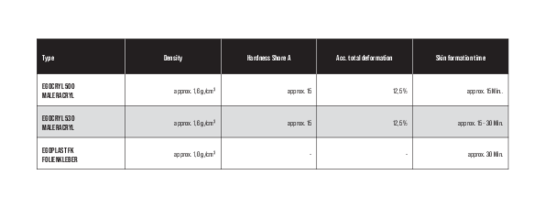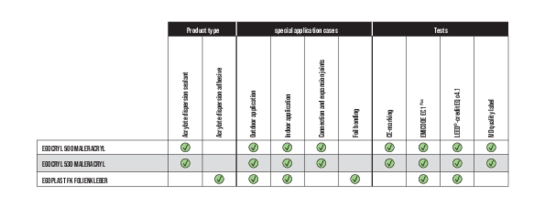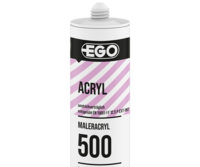
EGO ACRYLIC
With our selection of different EGOCRYL products, not only joints and cracks in the masonry can be sealed, but also joints in wooden flooring. It is used wherever the expansion stress and moisture load are low. Of course, our acrylic sealants can also be painted over and processed very well – this is not always the case with other sealants. The solvent-free grout is based on an aqueous Dispersion, dries quickly and is even odourless. The right sealant for every application – this is what we do!
Possibilities of density, Shore A hardness, acc. Total deformation nd skon formation time.
Possibilities of protct types, spec. Application cases and tests.
Excellently suited to:
- Sealing cracks and uneven surfaces
- Grouting window, door and ceiling connections, plastic pipes, lightweight construction walls and roller shutter boxes
- Grouting wooden floors, skirting boards and other finishes
EGOCRYL SEALANTS
Areas of application
EGOCRYL products are basically sealing compounds made out of acrylates that are used, among other things, to seal joints and cracks in masonry, wooden floors and connection joints. The material is always in demand when expansion stress and moisture load are not so high. An absorbent substrate is absolutely required in order to use this type. This is the case with masonry and concrete, but also with fibre cement, plaster and render. Of course, the acrylic adhesives can also be used on wood-based materials. We recommend it for sealing cracks and for connection joints with moderate loads.
For example, you can seal connection joints of doors and windows as well as ceilings with EGOCRYL. You can also use it to joint plastic pipes, lightweight walls and roller shutter boxes! Even skirting boards can be fixed in place using our products.
DIFFERENCES BETWEEN ACRYLIC AND SILICONE SEALANT
Both silicone sealant and acrylic sealant are usually paste-like in consistency. Cross-linked silicones have an elastic “rubbery” consistency, while acrylates remain plastically deformable in the hardened state.
Moisture resistance plays an important role in sanitary areas and kitchens. Silicone sealants are used here. However, silicone cannot be painted over. If the joint needs to be colour-matched for visual reasons, you can use EGO ACRYL sealants because they can be painted over. With acrylate sealants, cracks can be repaired and painted over and missing areas or holes can be wallpapered over. This is not possible with silicone sealant.
On the other hand, acrylates can only be subjected to slight expansion compared to silicones. There is a risk that these will crack if placed under too much stress.
Another important difference is the solubility: If you rub silicones between your fingers, they form a sticky film of lubricant that is not so easy to remove. Acrylates are different: They can be ground into small lumps and dissolve. The moist mass is water-soluble, which is not the case with silicones. Silicones can only be removed with special silicone removers or mechanically with a joint cutter, trowel or blade.
Acrylic sealants are normally cheaper and have a shorter drying time than silicones.
WORKING WITH ACRYLIC SEALANTS
Like silicone sealants, EGOCRYL is supplied ready to use, the cartridges can simply be inserted into the intended squeeze gun or cartridge press. With a little dexterity and practice, you will quickly develop a feeling for the perfect application of the sealant in terms of application quantity and material flow. The 310 ml plastic cartridges can be applied using commercially available squeeze guns, such as those used for silicone cartridges. A special acrylic press or gun is not necessary. Cracks and connections can be sealed with acrylic sealants as well as with silicones.
TOOLS FOR APPLYING ACRYLIC SEALANT
When applying acrylic joints, in addition to the press and the cartridge, you should also have a bowl with some water, a piece of wood or rubber for smoothing, a cutter and a joint scraper. Newspaper, paper towels and tape are also helpful. Essentially, you need all the things that you need when grouting with silicone.
SEALING JOINTS WITH ACRYLATE? EGOCRYL
EGOCRYL acrylates provide high-quality sealants for every area of application. As well as universal acrylic, you will find painter’s acrylic, parquet acrylic and structure acrylic in our range. And we even have a special acrylic-based film adhesive FK EGOPLAST. EGOPLAST FK is a permanent, odourless, thixotropic pressure-sensitive adhesive.
Frequently asked questions
Depending on the product quality, EGO acrylates can be used in various areas of application:
- For sealing interior/exterior and connection joints as well as movement joints with moderate expansion stress and without permanent moisture load on all absorbent substrates such as concrete, porous concrete, fibre cement, render, plaster boards, lime sandstone, brickwork, bare and anodised aluminium, hard PVC and timber.
- For grouting windows, door and ceiling connections, plastic pipes, lightweight walls, roller shutter boxes and cracks. For repairing uneven surfaces, for sealing cracks and joints that are plastered, painted or wallpapered over.
- For sealing joints in all types of wood flooring before or after wood sealing. For grouting skirting boards and other connections.
- For sealing cracks in plaster and masonry as well as decorative sealing of joints.
Not suitable for use on glass, glazed surfaces (such as enamel and tiles) and metals without acid-resistant surfaces. In general, the bonding surfaces should be stable, free from dust and free from de-bonding agents.
Fully painted sealant joints tend to crack with joint movements since the paint applied accommodates less expansion than the sealant underneath. DIN 18540 states that “Joint sealants should not be painted over.” In practice, acrylates and SMP sealants are painted over, but silicone sealants are not. If you wish to paint over the sealant, the sealant should first be tested according to DIN 52452-4/A3.
Before restoring old joints, the old grout must be removed. This is because the acrylic compound only holds in a clean and dry joint.
The sealant must be removed mechanically with a suitable tool, such as a joint cutter. The substrate should then be stable, clean, dry and free of dust.
It depends on the appearance and the requirements. What do you expect from the result? If the acrylic is only yellowed but still intact, you can paint or wallpaper over it. If the compound is brittle and falls out of the joint almost on its own or if it has cracks, you should remove the old compound and grout it again. You can then paint or wallpaper over it again.
Acrylates last longest at constant temperatures and low humidity. This means that you should keep the cartridges with the sealant tightly sealed and store them in a cool and dark place that is not damp. Temperatures between +10 and +20 degrees Celsius are perfectly fine. It is important to store the acrylic frost-free, i.e. not to expose it to frost for a longer period of time.
In general, original sealed tubular bags are more Diffusion-resistant than cartridges and, depending on the product, also have a slightly longer shelf life.
The acrylate sealant should be processed before the expiry date. If the cartridges are opened, the acrylic can dry on the cartridge opening and on the bottom of the piston base and cause lumps.
In practice, e.g. on the construction site, a screw is often inserted to seal the nozzle opening, a nail is inserted, or the sealable nozzles are inserted or sealed with adhesive tape to extend the shelf life.
The substrate must be clean and dry, ideally free of dust and small parts which may come loose (stable substrate). If this is the case, you do not need to prepare the substrate any further.
For highly absorbent building materials, it is best to dilute the acrylate sealant with water at a ratio of 1:4 and use it as a Primer or undercoat.
However, old joints must be redone, i.e. the old grout must be mechanically removed (scraped out) and cleaned before you can grout them again.
No, acrylic sealants are not waterproof. If you need the result to be waterproof, silicones are more suitable.
At first glance, you can hardly tell the difference when looking at an intact joint. Acrylic sealants, however, turn yellow over time and become brittle. Old joints therefore definitely show what material they are filled with. If you can stretch the grout like a rubber band, it is definitely silicone. Acrylic tears during this treatment.
